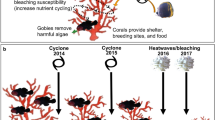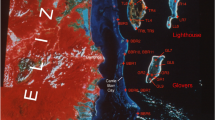Abstract
Coral reefs are declining dramatically and losing species richness, but the impact of declining biodiversity on coral well-being remains inadequately understood. Here, we demonstrate that lower coral species richness alone can suppress the growth and survivorship of multiple species of corals (Porites cylindrica, Pocillopora damicornis and Acropora millepora) under field conditions on a degraded, macroalgae-dominated reef. Our findings highlight the positive role of biodiversity in the function of coral reefs, and suggest that the loss of coral species richness may trigger negative feedback that causes further ecosystem decline.
This is a preview of subscription content, access via your institution
Access options
Access Nature and 54 other Nature Portfolio journals
Get Nature+, our best-value online-access subscription
$29.99 / 30 days
cancel any time
Subscribe to this journal
Receive 12 digital issues and online access to articles
$119.00 per year
only $9.92 per issue
Buy this article
- Purchase on Springer Link
- Instant access to full article PDF
Prices may be subject to local taxes which are calculated during checkout


Similar content being viewed by others
Data availability
Datasets used in this study are available online from the BCO-DMO data system (http://bco-dmo.org/).
References
Naeem, S., Duffy, J. E. & Zavaleta, E. Science 336, 1401–1406 (2012).
Hooper, D. U. et al. Nature 486, 105–108 (2012).
Bellwood, D. R., Hughes, T. P., Folke, C. & Nystrom, M. Nature 429, 827–833 (2004).
Mumby, P. J. & Steneck, R. S. Trends Ecol. Evol. 23, 555–563 (2008).
Connell, J. H. Science 199, 1302–1310 (1978).
Hoegh-Guldberg, O. et al. Science 318, 1737–1742 (2007).
Hughes, T. P. et al. Nature 543, 373–377 (2017).
Holbrook, S. J. et al. PLoS ONE 10, e0124054 (2015).
Messmer, V. et al. Ecology 92, 2285–2298 (2011).
Romeo, M. D. & Helen, T. Y. Mar. Ecol. Prog. Ser. 296, 165–172 (2005).
Cabaitan, P. C., Yap, H. T. & Gomez, E. D. Restor. Ecol. 23, 349–356 (2015).
Zhang, S. Y. et al. PeerJ 2, e308 (2014).
Wellington, G. M. Oecologia 47, 340–343 (1980).
Clements, C. S., Rasher, D. B., Hoey, A. S., Bonito, V. E. & Hay, M. E. Mar. Ecol. Prog. Ser. 586, 11–20 (2018).
Rasher, D. B., Hoey, A. S. & Hay, M. E. Ecology 94, 1347–1358 (2013).
Stachowicz, J. J., Bruno, J. F. & Duffy, J. E. Annu. Rev. Ecol. Evol. Syst. 38, 739–766 (2007).
Hooper, D. U. et al. Ecol. Monogr. 75, 3–35 (2005).
Dullo, W. C. Facies 51, 33–48 (2005).
Nugues, M. M. & Bak, R. P. M. Mar. Ecol. Prog. Ser. 315, 75–86 (2006).
Edwards, K. F., Aquilino, K. M., Best, R. J., Sellheim, K. L. & Stachowicz, J. J. Ecol. Lett. 13, 194–201 (2010).
Civitello, D. J. et al. Proc. Natl Acad. Sci. USA 112, 8667–1671 (2015).
Ostfeld, R. S. & Keesing, F. Annu. Rev. Ecol. Evol. Syst. 43, 157–182 (2012).
Raymundo, L. J., Halford, A. R., Maypa, A. P. & Kerr, A. M. Proc. Natl Acad. Sci. USA 106, 17067–17070 (2009).
Aeby, G. S., Bourne, D. G., Wilson, B. & Work, T. M. J. Mar. Biol. 2011, 1–8 (2011).
Gignoux-Wolfsohn, S. A., Marks, C. J. & Vollmer, S. V. Sci. Rep. 2, 804 (2012).
Johnson, P. T., Ostfeld, R. S. & Keesing, F. Ecol. Lett. 18, 1119–1133 (2015).
Kayal, M., Lenihan, H. S., Pau, C., Penin, L. & Adjeroud, M. Coral Reefs 30, 827–837 (2011).
Johnston, L. & Miller, M. W. Coral Reefs 33, 1047–1056 (2014).
Tilman, D., Isbell, F. & Cowles, J. M. Annu. Rev. Ecol. Evol. Syst. 45, 471–493 (2014).
Williams, S. L., Ambo-Rappe, R., Sur, C., Abbott, J. M. & Limbong, S. R. Proc. Natl Acad. Sci. USA 114, 11986–11991 (2017).
Lefcheck, J. S. et al. Proc. Natl Acad. Sci. USA 115, 3658–3662 (2018).
Shaver, E. C. & Silliman, B. R. PeerJ 5, e3499 (2017).
Ladd, M. C., Miller, M. W., Hunt, J. H., Sharp, W. C. & Burkepile, D. E. Front. Ecol. Environ. 16, 239–247 (2018).
Bonaldo, R. M. & Hay, M. E. PLoS ONE 9, e85786 (2014).
Baird, A. H., Guest, J. R. & Willis, B. L. Annu. Rev. Ecol. Evol. Syst. 40, 551–571 (2009).
Darling, E. S. et al. Ecol. Lett. 15, 1378–1386 (2012).
Rasher, D. B. & Hay, M. E. Proc. Natl Acad. Sci. USA 107, 9683–9688 (2010).
Rasher, D. B., Stout, E. P., Engel, S., Kubanek, J. & Hay, M. E. Proc. Natl Acad. Sci. USA 108, 17726–17731 (2011).
Loya, Y. et al. Ecol. Lett. 4, 122–131 (2001).
Pratchett, M. S. Pac. Sci. 61, 113–120 (2007).
Kayal, M. et al. PLoS ONE 7, e47363 (2012).
Acknowledgements
We thank the Fijian government and the Korolevu-i-wai district elders for collection and research permissions, and V. Bonito for scientific and cultural support. Financial support came from the National Science Foundation (OCE 0929119), National Institutes of Health (2 U19 TW007401-10) and Teasley Endowment to the Georgia Institute of Technology.
Author information
Authors and Affiliations
Contributions
C.S.C. and M.E.H. conceived the study. C.S.C. conducted the research with minor help from M.E.H. C.S.C. carried out the data analysis. C.S.C. and M.E.H. wrote the paper.
Corresponding author
Ethics declarations
Competing interests
The authors declare no competing interests.
Additional information
Publisher’s note: Springer Nature remains neutral with regard to jurisdictional claims in published maps and institutional affiliations.
Supplementary information
Supplementary Information
Supplementary Figures and Tables
Rights and permissions
About this article
Cite this article
Clements, C.S., Hay, M.E. Biodiversity enhances coral growth, tissue survivorship and suppression of macroalgae. Nat Ecol Evol 3, 178–182 (2019). https://doi.org/10.1038/s41559-018-0752-7
Received:
Accepted:
Published:
Issue Date:
DOI: https://doi.org/10.1038/s41559-018-0752-7
This article is cited by
-
Contact-free impacts of sessile reef organisms on stony coral productivity
Communications Earth & Environment (2023)
-
Variable intraspecific genetic diversity effects impact thermal tolerance in a reef-building coral
Coral Reefs (2023)
-
Fish community structure and dynamics are insufficient to mediate coral resilience
Nature Ecology & Evolution (2022)
-
Did the historic overharvesting of sea cucumbers make coral more susceptible to pathogens?
Coral Reefs (2022)
-
The role of predators in coral disease dynamics
Coral Reefs (2022)



